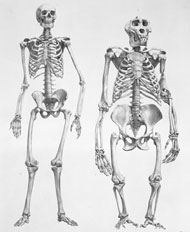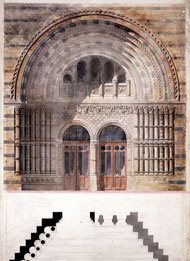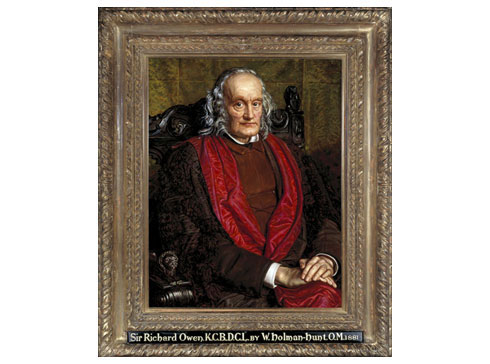Richard Owen painting
Richard Owen created the Natural History Museum, and was the first superintendent. The year the Museum opened, this portrait was painted by William Holman Hunt, one of the most significant artists of his time.

Drawing of a human skeleton (left) and a gorilla skeleton by Richard Owen, 1866.
Finding his vocation
Richard Owen's teachers would not have predicted that the schoolboy prankster would become the eminent scientist shown in this portrait. But while training to be a surgeon he was taught to compare the body structures of humans with other animals, and his attention finally focused. He had found the vocation that would drive him to the top of the scientific ranks.
Owen led the science of comparative anatomy for almost 60 years, naming and describing hundreds of species.
He rose to fame in 1832 by publishing Memoir on the Pearly Nautilus, which is still in print today.
A man of contradictions
Owen was hugely respected by his peers, but also feared and resented. He guarded his professional reputation aggressively, challenging anyone who stood in his way. He clashed with Charles Darwin over opposing theories of evolution, and their friendship never recovered.
In contrast, Owen’s family relationships were warm and loving.

Design for the main entrance of the Natural History Museum, sketched by architect Alfred Waterhouse in about 1872. © RIBA Library Drawings Collection
Our Museum is born
In 1856, the role of superintendent of natural history was created for Owen at the British Museum.
By now the most powerful scientist in the country, he lobbied for the natural history specimens to be moved to a separate museum.
Owen was determined to create a building that would do justice to the amazing diversity of nature and enable both scientists and the public to learn more about the national collections.
The first stones of our building at South Kensington in London were laid in 1873. Owen's ambitious plan was finally realised when this museum opened to the public in 1881.
Preserved in oil
That same year, William Holman Hunt painted Owen's portrait. A founding member of the Pre-Raphaelite Brotherhood, Hunt was one of the most famous artists of his day.
The Pre-Raphaelites' vibrant new approach to art reflected the dynamic and changing Victorian society. They painted often controversial social, religious and natural themes. The portrait of Owen is 1 of only 3 known portraits by Hunt - a fitting tribute to a remarkable, complex man.
Further information
- Visit Richard Owen's portrait in our new Treasures Cadogan Gallery.
- Tour the Museum online and discover what we owe to Owen's vision.
- Find out more about the life and achievements of Richard Owen.
- Discover the story of one of Owen's most dramatic accomplishments, the prediction of a giant flightless bird from a 15cm bone fragment.
- Uncover Owen's more devious side in the tales of the dodo skeleton and Iguanodon teeth.
Vote for your favourite treasure
Is this your favourite Museum treasure? Let us know by voting in our poll.

